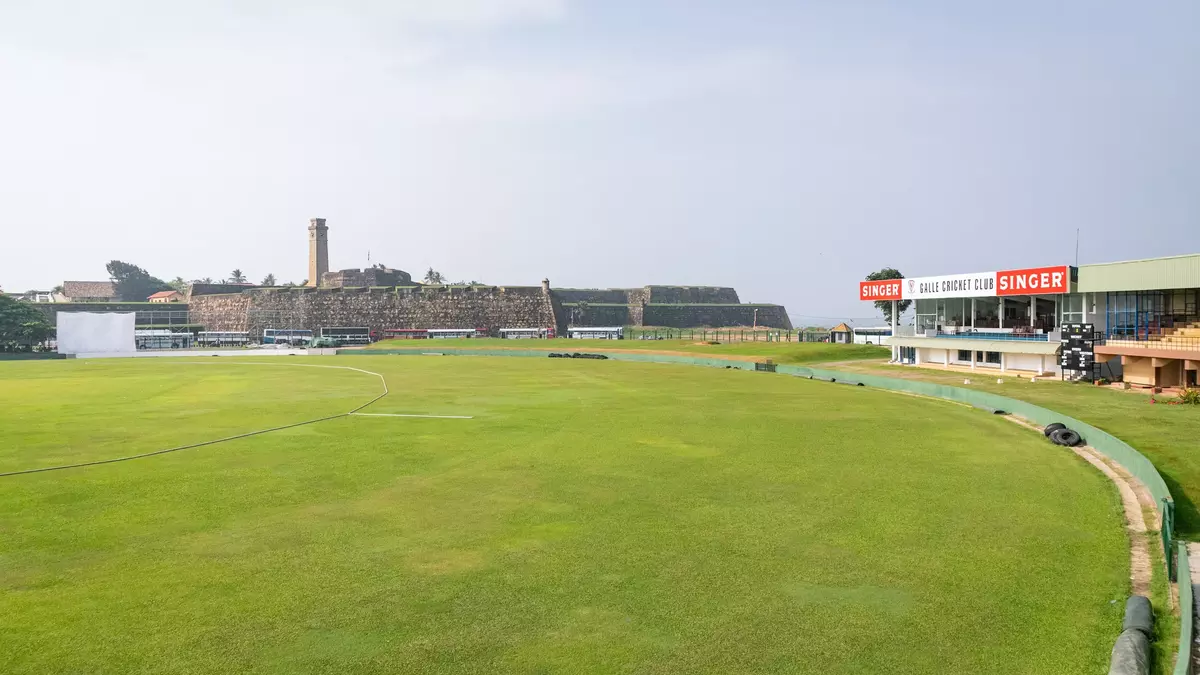
Galle International Stadium, a cornerstone in the cricketing world, boasts a rich history dating back to 1876.
Originally known as “The Esplanade“, this iconic ground in Galle, Sri Lanka, has evolved into a premier cricket venue.
With a seating capacity of around 35,000, it stands out among cricket grounds for its picturesque setting, bordered by the Indian Ocean on two sides and the 16th-century Dutch fort on another.
The stadium’s ambiance is unmatched, offering a unique spectator experience where the serene backdrop of the ocean meets the thrill of the sport.
Renowned for its pitch that significantly favors spin bowlers, Galle International Stadium has been a stage for numerous memorable cricketing events, etching its name in the annals of cricket history.
Summary & Key Takeaways
ShowThe History of Galle International Stadium
- Origin as Racecourse: Began in 1876, originally a racecourse.
- Transition to Cricket: First cricket pavilion in 1892, school cricket match in 1888.
- Official Cricket Stadium Status: Became a cricket stadium in 1927.
- Introduction of Turf Wicket: Turf wicket in 1945, first-class matches from 1984.
- International Status: First international Test in 1998, becoming Sri Lanka's seventh international cricket venue.
- Tsunami and Renovation: Damaged by 2004 tsunami, extensive renovations in 2006.
- Reopening and Enhancements: Reopened in 2007 with increased capacity, new pavilion, and media center.
- Historic Moments: Hosted Muttiah Muralitharan's final match in 2010; resumed ODIs in 2017.
Stadium Capacity
- Seating Capacity: Holds 35,000 spectators.
- Comparison with Other Stadiums: Comparable to Rangiri Dambulla International Stadium.
- Post-Renovation Increase: Significant capacity increase post-2006 renovation.
Pitch and Conditions
- Pitch Nature: Spinner-friendly, dry and dusty.
- Impact of Weather: High humidity, affected by Southwest Monsoon.
- Match Statistics: Hosted 43 Tests, favoring teams batting first.
- Pitch Measurements and Turf: 75 yards boundary, blue grass turf.
Memorable Matches and Moments
- Muttiah Muralitharan's Milestones: 500th Test wicket in 2004, 800th in his final Test in 2010.
- Notable Test Matches: Inaugural Test in 1998 against New Zealand, victory over England in 2012.
- Dramatic Test Victories: Kusal Perera's 153* leading to a one-wicket win against South Africa in 2019.
- High Scores and Collapses: Sri Lanka's 638 against Bangladesh in 2013, New Zealand's 73 in 2012.
- ODI Highlights: First ODI century by Solomon Mire in 2017 against Zimbabwe.
- Post-Tsunami Reconstruction: Reopened in 2007, first Test against England ended in a draw.
Facilities and Features
- Spectator Amenities: Excellent sightlines, natural ventilation, ocean views.
- Hospitality Services: Mahinda Rajapaksa Pavilion with VIP seating and media center.
- Parking and Transportation: Accessible location near Galle Fort, connected by bus and train.
- Player Facilities: Indoor and outdoor practice nets, player dressing rooms.
Visitor Information: Location and Tips
- Location: Next to Galle Fort, Colombo Road, Galle 80000.
- Accessibility: Near Colombo, accessible by bus and train.
Architecture of Galle International Stadium
- Architectural Style: Blend of modern and traditional Sri Lankan architecture.
- Design Philosophy: Emphasizes natural ventilation and excellent sightlines.
- Stadium Layout: 4.216 hectares, indoor and outdoor nets, 75-yard boundary.
- Iconic Features: Mahinda Rajapaksa pavilion, media center.
- Renovations and Upgrades: Post-tsunami reconstruction with international support, respecting Galle Fort's heritage.
Galle International Stadium: The Iconic Cricket Ground in Sri Lanka

Galle International Stadium, with its history stretching back to the 19th century, is a standout cricket venue in Sri Lanka.
Known for its sizable capacity and stunning oceanic backdrop, it creates an unforgettable atmosphere for spectators.
The pitch, favoring spin bowling, has witnessed many significant cricket events, including hosting an IPL team, cementing its place in cricket lore.
The History of Galle International Stadium
Galle International Stadium’s journey began in 1876 as a racecourse. It wasn’t until 1892 that it saw its first permanent pavilion, spearheaded by P. A. Templer, Secretary of the Galle Municipal Council.
As time progressed, cricket replaced racing, with the first school cricket match occurring in 1888. The venue, initially known as ‘Galle Esplanade‘, was officially designated as a cricket stadium in 1927.
The introduction of a turf wicket in 1945 marked a significant advancement, preparing it for first-class matches, which began in 1984.
The stadium elevated its status further, hosting its inaugural international Test match in 1998 between Sri Lanka and New Zealand. This transition to international cricket standards made it Sri Lanka’s seventh such facility.
Tragedy struck in 2004 when a devastating tsunami caused significant damage to the stadium.
Post-tsunami, extensive renovations commenced in 2006, culminating in a grand reopening in 2007 with an increased seating capacity, a new pavilion, and a media centre.
The stadium has witnessed numerous historic cricketing moments, notably hosting the final match of Sri Lankan cricket legend Muttiah Muralitharan in 2010.
Additionally, in 2017, it broke a 20-year hiatus by hosting One-Day Internationals, marking another milestone in its storied existence.
Stadium Capacity
Galle International Stadium, known for its scenic location in Sri Lanka, holds a capacity of 35,000 spectators.
This capacity places it among the larger stadiums in Sri Lanka, comparable to others like the Rangiri Dambulla International Stadium which seats 16,800.
Following its renovation in 2006, the stadium saw a significant increase in seating capacity, accommodating more spectators and enhancing the overall experience.
In comparison to other international cricket grounds in the country, Galle International Stadium stands out for its size.
It shares the same capacity with another major stadium in the country, but significantly surpasses others, which have capacities ranging from 6,000 to 15,000.
Pitch and Conditions
Galle International Stadium’s pitch is predominantly a spinner’s paradise, known for its dry, dusty surface that increasingly favors spin bowling as a match progresses.
This characteristic has historically given spinners a significant advantage, often resulting in high wicket totals for them.
Typically, matches at Galle are inclined to conclude within four days, particularly as the pitch deteriorates, making run-scoring challenging in later stages of a Test match.
The stadium’s location in Galle, a seaside city with tropical weather, introduces another layer of complexity.
High humidity levels are a constant feature, and the Southwest Monsoon, lasting from May to September, brings substantial rain, impacting match schedules. These weather conditions can greatly influence the playability of the pitch.
Historically, the Galle International Stadium has hosted 43 Tests, with Sri Lanka winning 25 of them.
Statistics show a notable dominance by teams batting first, with 23 wins, compared to 14 wins for teams batting second.
The ground also boasts records like the highest individual score of 333 and best bowling figures in a match of 13/171.
Additionally, the average first-innings score here is around 367, highlighting the pitch’s initial favorability for batting.
The pitch, measuring 75 yards from wicket to boundary, utilizes blue grass turf. This specific choice of turf contributes to the unique playing conditions, reinforcing the stadium’s reputation for favoring spin bowling.
As such, Galle International Stadium remains a challenging and strategic venue for cricketers, especially spin bowlers and batsmen adept at playing spin.
Memorable Matches and Moments
Galle International Stadium has witnessed numerous iconic cricketing events, each contributing to its rich history. Here are some standout moments:
Muttiah Muralitharan’s Milestones
This ground was pivotal in Muttiah Muralitharan’s career. In 2004, he claimed his 500th Test wicket here against Australia.
His farewell Test in 2010 was equally memorable, as he achieved the remarkable feat of 800 Test wickets, a record-breaking milestone in his final game.
Significant Test Matches
The inaugural Test match at the stadium was held from June 3-7, 1998, against New Zealand, with Sri Lanka emerging victorious.
Another remarkable instance was in 2012, where Sri Lanka claimed their first Test match victory over England at Galle, with Rangana Herath taking 12 wickets.
Dramatic Test Victories
In 2019, Kusal Perera’s unbeaten 153 against South Africa led Sri Lanka to a stunning one-wicket victory, one of the most dramatic finishes in the stadium’s history.
Record-Breaking Performances
The ground has seen both high scores and dramatic collapses. Sri Lanka’s 638 against Bangladesh in 2013, featuring Kumar Sangakkara’s double century, and New Zealand’s lowest score of 73 in 2012 are notable.
Kumar Sangakkara also made the highest individual score of 230 runs without being dismissed against Pakistan in 2002.
ODI Highlights
The first ODI match scheduled here was in 1998 between Sri Lanka and India, abandoned due to rain.
In June 2017, Zimbabwe toured Sri Lanka, marking the stadium’s first ODI in 20 years. Zimbabwean opener Solomon Mire scored the venue’s first ODI century, leading to the highest ODI chase on Sri Lankan soil.
Natural Disasters and Reconstruction
The 2004 Indian Ocean tsunami devastated the stadium, leading to significant reconstruction. The stadium was reopened in December 2007, with the first Test match post-renovation between Sri Lanka and England ending in a draw.
Facilities and Features
The Galle International Stadium offers an impressive seating layout ensuring excellent sightlines and optimal viewing angles.
Every seat guarantees unobstructed views, with the added allure of ocean vistas due to the stadium’s coastal proximity.
Additionally, the design emphasizes natural ventilation, using open spaces and windows to facilitate airflow, enhancing comfort in hot, humid conditions.
Hospitality Services
The Mahinda Rajapaksa Pavilion, added during post-tsunami renovations, provides seating for up to 500 guests, including 130 VIPs. It houses a media center capable of accommodating 150 media personnel, two TV control rooms, and a radio commentators’ room.
Parking and Transportation
Located next to Galle’s Fort area, the stadium is easily accessible. The nearest international airport is in Colombo, 160km away.
The Galle bus station, adjacent to the cricket ground, connects to major cities, while the Galle Railway Station, a 5-minute walk from the stadium, offers scenic train journeys alongside the Indian Ocean.
Player Facilities
The stadium includes three indoor practice nets and four outdoor nets, catering to player training needs. The dressing rooms for teams are located in the Mahinda Rajapaksa Pavilion.
Visitor Information: Location and Tips
Galle International Stadium, located at Colombo Road, Galle 80000, is next to the Fort area of Galle. The closest international airport is in Colombo, about 160 km away.
For public transportation, the bus station adjacent to the cricket ground connects to Colombo, Hikkaduwa, and Matara.
The Galle Railway Station, a mere 5-minute walk from the stadium, offers scenic train journeys along the Indian Ocean to various destinations including Colombo, Matara, Mirissa, and Kandy.
Architecture of Galle International Stadium
The Galle International Stadium, situated near the Galle Fort and the Indian Ocean in Sri Lanka, is renowned for its picturesque setting and historical significance.
Architectural Style
The Stadium’s architecture is a harmonious blend of modern elements and traditional Sri Lankan architecture, characterized by vibrant colors, intricate patterns, and decorative motifs.
Materials like teak wood and coral stone, sourced locally, enhance its strong connection to the environment.
Its design recalls ancient fortresses, with sturdy walls that provide both security and a shield against coastal winds.
Design Philosophy
The design prioritizes natural ventilation, with open spaces and strategically placed windows ensuring pleasant airflow, which is especially beneficial during hot and humid conditions.
The stadium’s layout is planned to ensure excellent sightlines and optimal viewing angles, with tiered seating arrangements offering unobstructed views from every seat.
Its proximity to the coastline allows for breathtaking ocean views, enhancing the experience for spectators.
Stadium Layout
Covering an area of 4.216 hectares, the ground includes features like three indoor practice nets and four outdoor nets.
The distance from the wicket to the boundary is 75 yards, and blue grass is used on the turf. The stadium has facilities for both players and spectators, ensuring a comprehensive cricketing environment.
Iconic Features
The Mahinda Rajapaksa pavilion, added during post-tsunami renovations, is an iconic feature.
It can seat up to 500 VIP guests and includes a media center that accommodates 150 media personnel, two TV control rooms, and a radio commentators’ room. The dressing rooms of the teams are also located in this pavilion.
Renovations and Upgrades
The stadium underwent significant renovations starting in May 2006, which involved constructing new buildings like a new pavilion and a media center, and increasing seating capacity.
The cost of reconstruction was approximately Rs. 500,000,000, with international support, including significant contributions from Surrey County Cricket Club, and cricketers Shane Warne and Ian Botham.
During renovations, there were concerns about new constructions blocking the view of the adjacent Galle Fort, a UNESCO World Heritage Site, but this issue was resolved later.
Final Words on Galle International Stadium
Galle International Stadium, a remarkable cricketing venue in Sri Lanka, symbolizes resilience and sporting spirit.
From its humble beginnings as a racecourse in 1876, it has evolved into a premier cricket stadium, hosting its first international Test in 1998.
The stadium’s transformation was further exemplified by extensive renovations following the 2004 tsunami, emerging as a modern facility with enhanced capacity and improved amenities.
Notable for its picturesque setting near the Galle Fort, it boasts a rich history, including being the stage for Muttiah Muralitharan’s legendary career milestones.
With a pitch favoring spin bowlers and a capacity of 35,000, it stands as a testament to the enduring love for cricket in Sri Lanka.
Galle International Stadium weaving together tales of historic matches, architectural beauty, and a deep connection to its local culture and environment.
All You Need to Know about Galle International Stadium
What type of pitch is Galle Cricket Stadium?
Galle International Stadium is known for its slow, turning pitches that favor spin bowling. The pitch is traditionally dry and hard, which makes it difficult for batsmen to score runs quickly. However, the pitch can also be unpredictable, and there have been some high-scoring matches played here in recent years.
How many cricket stadiums are there in Colombo?
There are four cricket stadiums in Colombo, Sri Lanka. They are:
- Sinhalese Sports Club Ground
- R. Premadasa Stadium
- Colombo Cricket Club Ground
- P Sara Oval
What is the history of Galle Cricket Stadium?
Galle International Stadium is a cricket stadium in Galle, Sri Lanka. It is situated near Galle Fort and fringed on two sides by the Indian Ocean. It is considered to be one of the most picturesque cricket grounds in the world.
The stadium was built in 1876 as a racecourse. It was converted into a cricket ground in 1927. The stadium has hosted a number of international cricket matches, including two Test matches between Sri Lanka and England in 1982.
In December 2004, the stadium was severely damaged by the tsunami that struck Sri Lanka. The stadium was rebuilt and reopened in 2007.
Galle International Stadium is a popular tourist destination. Visitors can take a tour of the stadium and learn about its history. The stadium is also a popular venue for weddings and other events.










